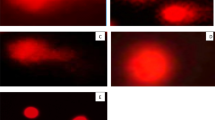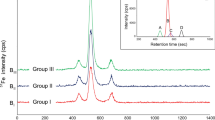Abstract
The study was designed to assess the effect of several Fe amounts and sources on haematological parameters, DNA, lipid and protein oxidative damage during the course of Fe-deficiency anaemia recovery. Peripheral DNA damage was assessed using an alkaline comet assay. The brain, liver, erythrocyte and duodenal mucosa lipid peroxidation and protein damage were assessed in control and anaemic rats after Fe repletion with three different sources (FeSO4, haem Fe, and FeSO4 + haem Fe) and amounts (45, 12, and 31 mg Fe/kg diet) of Fe: F diet, H diet or C diet, respectively. After supplying the diets, the haematological parameters studied were recovered; being remarkable is the haemoglobin increase. The DNA damage was lower in rats with the H diet, as revealed by the percentage of DNA in head, tail and Olive tail moment compared in rats with the F (P < 0.001) and C (P < 0.05) diets. Lipid peroxidation was similar in all the tissues, except in the duodenal mucosa which was lower with H and C diets (P < 0.001). The animals fed with C diet showed lower oxidative protein damage in the duodenal mucosa (P < 0.001) and was also lower in the liver and erythrocytes for H and C diets (P < 0.001). No differences were found in the brain under our experimental conditions. In conclusion, Fe supplementation with low doses of haem Fe or combined forms of non-haem and haem Fe (FeSO4 + haem) are efficient in restoring the impaired haematological parameters and prevent the evoked oxidative stress associated with Fe supplements.
Similar content being viewed by others
References
Stephenson LS, Lathan MC, Ottesen EA (2000) Global malnutrition. Parasitology 121:S5–S22
Campos MS, Barrionuevo M, Alférez MJM, Gómez-Ayala AE, Rodríguez-Matas MC, López-Aliaga I, Lisbona F (1998) Interactions among iron, calcium, phosphorus and magnesium in nutritionally iron-deficient rats. Exp Physiol 83:771–781
Parkkila S, Niemela O, Savolainen ER, Koistinen P (2001) HFE mutations do not account for transfusional iron overload in patients with acute myeloid leukemia. Transfusion 41:828–831
Lisbona F, Reyes-Andrada MD, López-Aliaga I, Barrionuevo M, Alférez MJM, Campos MS (1999) The importance of the proportion of heme/nonheme iron in the diet to minimize the interference with calcium, phosphorus, and magnesium metabolism on recovery from nutritional ferropenic anemia. J Agric Food Chem 5:2026–2032
González R, Aznar E, González M, Hernández JC, Varela A, Silva P, García Y (2008) Nueva línea de productos para prevenir y tratar la anemia partiendo del hierro hemínico. Informacéutico 15:43–48
Aznar E, González R, González M (2001) Prevención de la deficiencia de hierro en embarazadas suplementadas con productos de origen natural, Neotrofín (tabletas) y Trofin®Vital (Líquido). Rev Cub Farm 35:269–273
Aznar E, González R, Moroño M, González M (1998) Tratamiento antianémico hierro-proteína (Trofin®) para uso Pediátrico. Rev Mex Cienc Farmac 29:18–21
Aust AE, Eveleigh JF (1999) Mechanisms of DNA oxidation. Proc Soc Exp Biol Med 222:246–252
Hubel CA, Kozlov AV, Kagan VE, Evans RW, Davidge ST, Mclauglin MK, Roberts JM (1996) Decreased transferrin and increased transferrin saturation in sera of women with pre-eclampsia: implications for oxidative stress. Am J Obstet Gynecol 175:692–700
Pietrangelo A (1998) Iron, oxidative stress, and liver fibrogenesis. J Hepatol 28:8–13
Dizdaroglu M, Nackerdien Z, Chao BC, Gajewski E, Rao G (1991) Chemical nature of in vivo base damage in hydrogen peroxide treated mammalian cells. Arch Biochem Biophys 285:388–390
Ghaffari S (2008) Oxidative stress in the regulation of normal and neoplastic hematopoiesis. Antioxid Redox Signal 10:1923–1940
Reeves PG, Nielsen FH, Fahey GC (1993) AIN-93 Purified diets for laboratory rodents: final report of the American Institute of Nutrition and ad hoc writing committee on the reformulation of the AIN-76A rodent diet. J Nutr 123:1939–1951
Pallarés I, Lisbona F, López-Aliaga I, Barrionuevo M, Alférez MJM, Campos MS (1993) Effects of iron deficiency on the digestive utilization of iron, phosphorus, calcium and magnesium in rats. Br J Nutr 70:609–620
Duthie SJ, Hawdon A (1998) DNA stability (strand breakage, uracil misincorporation, and defective repair) is increased by folic acid depletion in human lymphocytes in vitro. FASEB J 12:1491–1497
DeSandro V, Chevrier M, Boddaert A, Melcion C, Cordier A, Richiert L (1991) Comparison of the effects of propylthiouracil, diphenyl hydantoin, phenobarbital and 3 methylcholanthrene on hepatic and renal T4 metabolism and thyroid gland function in rats. Toxicol Appl Pharmacol 111:263–278
Hanahan DJ, Ekholm JE (1974) The preparation of red cell ghosts (membranes). Meth Enzymol 31:168–172
Lowry OH, Rosenburgh NJ, Farr AL, Randall RJ (1951) Protein measurement with folin phenol reagent. J Biol Chem 193:265–270
Yagi K (1976) A simple fluorometric assay for lipoperoxide in blood plasma. Biochem Med 15:212–216
Ohkawa H, Ohishi N, Yagi K (1979) Assay for lipid peroxides in animal tissues by thiobarbituric acid reaction. Anal Biochem 95:351–358
Reznick AZ, Packer L (1994) Oxidative damage to proteins: spectrophotometric method for carbonyl assay. Methods Enzymol 233:357–363
Strube YNJ, Beard JL, Ross AC (2002) Iron deficiency and marginal vitamin A deficiency affect growth hematological indices and the regulation of iron metabolism genes in rats. J Nutr 132:3607–3615
Beard JL, Brigham DE, Kelley SK, Green MH (1998) Plasma thyroid hormone kinetics are altered in iron-deficient rats. J Nutr 128:1401–1408
Díaz-Castro J, Alférez MJ, López-Aliaga I, Nestares T, Granados S, Barrionuevo M, Campos MS (2008) Influence of nutritional iron deficiency anemia on DNA stability and lipid peroxidation in rats. Nutrition 24:1167–1173
Schneider JM, Fujii ML, Lamp CL, Lönnerdal B, Dewey KG, Zidenberg-Cherr S (2008) The use of multiple logistic regression to identify risk factors associated with anemia and iron deficiency in a convenience sample of 12–36-mo-old children from low-income families. Am J Clin Nutr 87:614–620
Raghuveer P, Vidya P, Prabhu RS (2009) Iron overload in beta thalassemia—a review. J Biosci Tech 1:20–31
West AR, Oates PS (2008) Mechanisms of heme iron absorption: current questions and controversies. World J Gastroenterol 14:4101–4110
Theil EC, Raymond KN (1994) Metals in medicine. In: Bertini I, Gray HB, Lippard SJ, Valentine JS (eds) Bioinorganic chemistry. University Science Books, Mill Valley, pp 1–36
Hider RC, Kong XL (2010) Chemistry and biology of siderophores. Nat Prod Rep 27:637–657
Wang J, Pantopoulos K (2011) Regulation of cellular iron metabolism. Biochem J 434:365–381
Weinstein DA, Roy CN, Fleming MD, Loda MF, Wolfsdorf JI, Andrews NC (2002) Inappropriate expression of hepcidin is associated with iron refractory anemia: implications for the anemia of chronic disease. Blood 100:3776–3781
Ben-Assa E, Youngster I, Kozer E, Abu-Kishk I, Bar-Haim A, Bar-Oz B, Berkovitch M (2009) Changes in serum hepcidin levels in acute iron intoxication in a rat model. Toxicol Lett 189:242–247
Alayash AI, Patel RP, Cashon RE (2001) Redox reactions of hemoglobin and myoglobin: biological and toxicological implications. Antiox Redox Signal 3:313–327
Gil L, Siems W, Mazurek B, Gross J, Schroeder P, Voss P, Grune T (2006) Age-associated analysis of oxidative stress parameters in human plasma and erythrocytes. Free Rad Res 40:495–505
Crichton RR, Danielsson BG, Geisser P (2008) Iron metabolism: biologic and molecular aspects. In: Crichton RR, Danielsson BG, Geisser P (eds) Iron therapy with special emphasis on intravenous administration, 4th edn. UNI-Med Verlag AG, Bremen, pp 14–24
Crichton RR, Dexter DT, Ward RJ (2011) Brain iron metabolism and its perturbation in neurological diseases. J Neural Transm 118:301–314
Moos T, Rosengren NT, Skjørringe T, Morgan EH (2007) Iron trafficking inside the brain. J Neurochem 103:1730–1740
Díaz-Castro J, Pérez-Sánchez LJ, Ramírez López-Frías M, López-Aliaga I, Nestares T, Alférez MJ, Ojeda ML, Campos MS (2012) Influence of cow or goat milk consumption on antioxidant defence and lipid peroxidation during chronic iron repletion. Br J Nutr 108:1–8
Acknowledgments
Funding was provided by the Inter Ministerial Commission of Science and Technology (CICYT) research project no. AGL-2006-02301/ALI and by the Agencia Española de Colaboración Internacional para el Desarrollo (AECID). The authors are grateful to Ms. Elisa Alcover for her efficient administrative support and Encarnación Rebollo and Francisco Benítez for their technical assistance. The English revision of the manuscript was done by Carolina Martínez Vetter.
Author information
Authors and Affiliations
Corresponding author
Rights and permissions
About this article
Cite this article
Díaz-Castro, J., García, Y., López-Aliaga, I. et al. Influence of Several Sources and Amounts of Iron on DNA, Lipid and Protein Oxidative Damage During Anaemia Recovery. Biol Trace Elem Res 155, 403–410 (2013). https://doi.org/10.1007/s12011-013-9802-9
Received:
Accepted:
Published:
Issue Date:
DOI: https://doi.org/10.1007/s12011-013-9802-9




